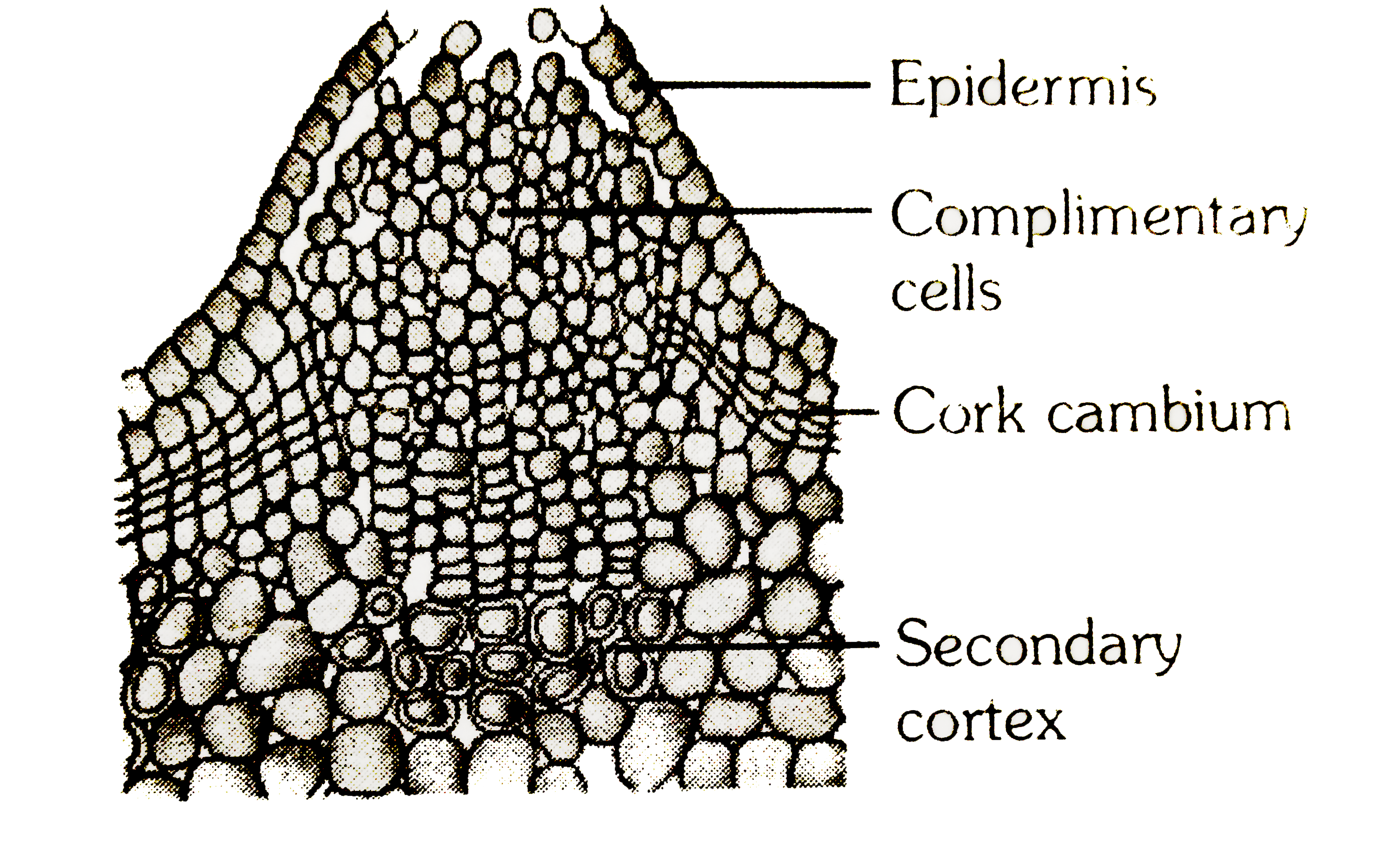Lenticels
Step-by-Step Solution for the Question on Lenticels
1. Definition of Lenticels:
Lenticels are small openings or pores found on the surface of stems and sometimes leaves of woody plants. They are primarily located in the lower epidermis.
2. Location:
Lenticels are predominantly found in the woody parts of the plant, such as the trunk and branches. They can appear as raised, circular, oval, or elongated areas on the surface.
3. Function of Lenticels:
The primary function of lenticels is to facilitate the exchange of gases between the plant and the external environment. They allow oxygen to enter the plant and carbon dioxide to exit.
4. Gas Exchange Process:
The gas exchange occurs between the outer atmosphere and the internal tissues of the stem. This process is crucial for the plant's respiration.
5. Respiration Role:
Lenticels play a vital role in respiration. They help the plant take in oxygen, which is necessary for cellular respiration, and release carbon dioxide as a byproduct.
6. Structure of Lenticels:
Lenticels are described as spongy areas that resemble small lenses or pores. Their structure allows for efficient gas exchange.
7. Importance to Ecosystem:
The oxygen released by the lenticels during respiration is essential for the survival of many organisms, including humans, as they depend on oxygen for their own respiration.
Lenticels are small openings or pores found on the surface of stems and sometimes leaves of woody plants. They are primarily located in the lower epidermis.
Lenticels are predominantly found in the woody parts of the plant, such as the trunk and branches. They can appear as raised, circular, oval, or elongated areas on the surface.
The primary function of lenticels is to facilitate the exchange of gases between the plant and the external environment. They allow oxygen to enter the plant and carbon dioxide to exit.
The gas exchange occurs between the outer atmosphere and the internal tissues of the stem. This process is crucial for the plant's respiration.
Lenticels play a vital role in respiration. They help the plant take in oxygen, which is necessary for cellular respiration, and release carbon dioxide as a byproduct.
Lenticels are described as spongy areas that resemble small lenses or pores. Their structure allows for efficient gas exchange.
The oxygen released by the lenticels during respiration is essential for the survival of many organisms, including humans, as they depend on oxygen for their own respiration.
Topper's Solved these Questions
- PLANT LIFEBOOK - ICSECHAPTER - PLANT LIFEEXERCISE - EXERCISES (SECTION II (DIFFERENTIATE BETWEEN THE FOLLOWING PAIR OF WORDS BASED ON WHAT IS GIVEN IN THE BRACKET))
5 Videos
- PLANT LIFEBOOK - ICSECHAPTER - PLANT LIFEEXERCISE - EXERCISES (SECTION II (SHORT ANSWER QUESTIONS))
6 Videos
- PLANT LIFEBOOK - ICSECHAPTER - PLANT LIFEEXERCISE - EXERCISES (SECTION I (GIVEN BELOW IS AN EXAMPLE OF A CERTAIN STRUCTURE AND ITS FUNCTIONAL ACTIVITY. ON A SIMILAR PATTERN, COMPLETE THE FOLLOWING))
5 Videos
- PHOTOSYNTHESIS AND RESPIRATION IN PLANTS BOOK - ICSECHAPTER - PHOTOSYNTHESIS AND RESPIRATION IN PLANTS EXERCISE - Exercises (Explain in brief.)
9 Videos
- THE NERVOUS SYSTEMBOOK - ICSECHAPTER - THE NERVOUS SYSTEMEXERCISE - EXERCISE (EXPLAIN IN BRIEF)
4 Videos
Similar Questions
Select true statements :-
(a) Lenticels are absent in woody climbers and leaves
(b) Lenticles occur in most woody trees
(c) The spring wood is lighter in colour and has a lower density
(d) The sap wood also called as duramen
View SolutionState true(T) or false(F) to the given statements and select the correct option.
( a ) Annual rings are distinct in plants growing in temperate regions.
( b ) Lenticels occur in most woody trees and permit the exchange of gases.
( c ) Due to stelar secondary growth, central cylinder of wood surrounded by secondary phloem is formed.
( d ) The cells of endodermis opposite to protoxylem divide to give rise vascular cambium in dicot roots.
View Solution
Knowledge Check
Which of the following statements are incorrect?
(i). Secondary growth usually occurs in monocotyledons.
(ii). Bark refers to all tissues interior to vascular cambium.
(iii). Lenticels permit the exchange of gases between the outer atmosphere and the internal tissue of the stem.
(iv). Annual rings give an estimate of the age of the tree.A(i) and (ii) onlyB(i) and (iii) onlyC(i) and (iv) onlyD(ii) and (iv) only
Choose between the two options to answer the question specified in the brackets for the following:
An example is illustrated below :
Example : Corolla or Calyx (Which is the outer whorl ?) Answer : Calyx
(i) Blood in the renal artery or renal vein (Which one has more urea ?)
(ii) Perilymph or endolymph (Which one surrounds the organ of Corti ?)
(iii) Lenticels or stomata (Which one remains open always?)
(iv) Sclerotic layer or choroid layer (Which one forms the Iris?)
(v) Blood in the pulmonary artery or pulmonary vein (Which one contains less oxyhaemoglobin?)
View SolutionLenticel and its complementary cells are developed through the activity of
View SolutionGiven diagram shows -

(a) Lenticel facilitating the air exchange
(b) Hydathode showing gaseous vapour exchange
(c) Fungus reproducing by spore formation
(d) Alga reproducing by spore formation
View SolutionMatch column I withcolun II and select the correct option from the given codes.
Column IColumn IIA. Bulliform cells(i). Regulate opening and closing of stomataB. Guard cells(ii). Aerating pores in the bark of plantC. Lenticels(iii). Rolling in and out leavesD. Subsidiary cells(iv). Accessory cells
View SolutionMatch column I withcolun II and select the correct option from the given codes.
Column IColumn IIA. Bulliform cells(i). Regulate opening and closing of stomataB. Guard cells(ii). Aerating pores in the bark of plantC. Lenticels(iii). Rolling in and out leavesD. Subsidiary cells(iv). Accessory cells
View SolutionThe function of the lenticel is
View SolutionMain function of lenticel is
View Solution
